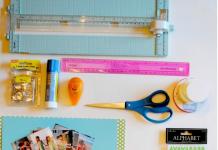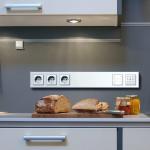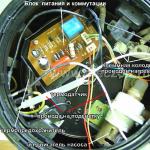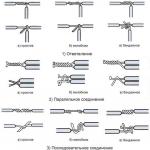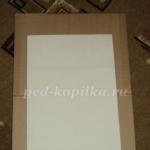For many owners of houses and apartments, installing and connecting sockets seems to be something complicated, which simply must be done exclusively by a master. In truth, this is not the case, and therefore this article will tell you how to make a do-it-yourself installation of an outlet block.
What you need to know before you get started
Nowadays, there are a huge variety of materials from which a wall can be made. There are plasterboard walls, stone walls, brick walls, concrete walls. Different installation technologies are used for them, since each of them has its own specifics.

Note
This article only describes how to install and connect the socket block, despite the fact that today we also have such a combination as a socket with a switch, but an article will be published about it some other time.

To install sockets, you need to know the dimensions of the socket blocks, and they are as follows:
- The size of one outlet is 72 millimeters wide and the same in height;
- The block size grid of 2 electrical points is 72 mm long and 142 mm wide;
- The block size grid of 3 electrical points is also 72 mm long and 212 mm wide;
- The grid of 4 parts is 284 mm wide and 72 mm high.
Safety during socket installation
The process of installing and connecting the outlet must be safe and fairly aesthetic. Let's talk about the first, professionals recommend installing sockets at a height of about forty centimeters from the floor, although most people install them at a height of about a meter.

Children should not have any access to sockets, so it is worth installing sockets with a protective cover that a small child will certainly not be able to break into.

detailed instructions
In order to simplify this work as much as possible, this article contains step-by-step instructions for mounting the socket block.
Prepare for installation
Before you start work, it is worth determining the place where you will place the outlet group. If this place is the kitchen, then the outlet should be placed just above the countertop, thereby ensuring that the cord from any kitchen equipment will successfully reach the outlet.

In case you plan to place sockets in the living room, it is best to do this behind the TV, which will hide all the wires.

Speaking about the bathroom, it must be taken into account that the sockets must be located at least 0.6 meters from the bathroom and be waterproof.

Wall marking process
A crucial stage that determines the quality of the installation of sockets and their connection. In order to implement it, it is necessary to lay sockets on the place where the sockets are installed, the number of sockets laid on depends on how many sockets will be present in the block.

When doing this work, be aware that there should be exactly 72 centimeters between the central parts of the sockets. By making a mistake in measurements, you guarantee yourself that the outlet cover will not fit.

Gating
This process is not as difficult as it sounds. It includes the creation of sockets for socket boxes. In this case, you need to have a puncher with the right nozzle.

If you are going to place the socket block in a concrete or brick wall, then it is vital for you to gouge the circles with a crown, and then knock out the core with a chisel.
Installation of socket boxes
It is also not the most difficult step in installing sockets, since today the market offers plastic cups created for this procedure that connect to each other. So even the most recent layman can handle it.
If the installation of socket boxes takes place in a concrete or brick building, then you need to cover the glasses with a plaster solution.

If you are dealing with drywall, then know that the implementation of the above procedure at sub-sockets is simple, since they have paws created for this, which are pressed against the sheet on the sides.


Electrical connection
After waiting for the substance to harden, you need to start turning on the indoor socket block to the 220V network. Several euro sockets can be connected to one electrical wiring line at once, but keep in mind that this is only done when you know that you will not connect, say, an electric stove.

And now to the point, to install and connect the socket blocks, you need to bring the lead wires coming from the junction box into the very first socket box: phase, zero and ground. Next, in order to connect other outlets, make jumpers.

Note
The above procedure is carried out with the electricity turned off in the apartment or house.

Having completed the work on connecting all the cores and terminals, you can install the socket covers yourself and compare the externally obtained result with the photo of the socket blocks below.

















(Last Updated On: 12/22/2017)
Today, electrical appliances combined in one unit, such as sockets and switches, are used much more often than traditional single products, because they are much more convenient to use. In addition, the installation of the socket block is not particularly difficult, and it is quite possible for a home master who has experience working with electrical appliances and electricians in general to do it with their own hands.
However, for residents of many modern houses there is no problem with the choice and installation of socket blocks, as, for example, for residents of new buildings in Domodedovo, where multifunctional blocks for sockets with numerous fuses and grounding are installed. In this case, only certified equipment is installed by licensed masters.
Variety of types and shapes of socket blocks
The wide distribution of such products is ensured by the fact that today they are presented in a variety of options, characterized by excellent ergonomics, a well-thought-out installation system and an attractive appearance. And the most important thing, probably, is that all the wires are now localized in one place, which is very convenient both at the stage of laying electrical wiring and at the stage of using sockets and switches.
If there are many electrical appliances in the room and, therefore, a large number of sockets are required, then it is better to give preference to the option of the unit built into a cabinet or a special rack. Through such blocks, it is possible to connect both directly and through emergency power sources, therefore, most often, socket blocks built into cabinets and racks are chosen for server rooms, large computerized classrooms, etc. One such block can have up to 12 sockets.
The standard options used in both administrative and residential premises are blocks with a diagonal of 10 and 19 inches. There are a lot of options for manufacturing socket blocks for widespread use, they can be made from a variety of materials, equipped with surge protection systems, safety shutters, which allows you to choose the right option for almost any room, regardless of its purpose and design solution.
How to connect a block with 3 or more sockets
In situations where it is required to provide the ability to connect more than 2 devices to the mains, it is more reasonable to use not separate sockets, but combined into 1 unit.
All sockets in such a block must be connected in parallel. Therefore, before installing and connecting the socket, you need to insert jumpers assembled from 3 different wires into each seat of each socket in the block. Therefore, for a block of 3 sockets, 3 jumpers and 9 separate wires are needed. The jumpers must be of optimal length so as not to interfere with the tight fixation of the socket in the socket.
When the jumpers are made, you can install the outlet in its intended place and proceed with the connection in the following order:
- you need to disassemble all the sockets in the block;
- jumpers between individual boxes, the cable or individual wires are stripped of insulation, while making sure that the cable coming from the junction box has a length with a margin - the margin will come in handy if you need to reconnect in the future;
- the first socket is connected according to the standard scheme, i.e. just like a separate outlet;
- the connected socket is installed in the mounting box, while it is important to observe the installation level;
- after that, in accordance with the color marking, all other sockets are connected and installed in the boxes. It is important to remember that only 3 wires should be connected to the last outlet in the block;
- the installed sockets are closed with an external cover, while it is important to clearly align the slots for the plug with the socket inputs.
As you can see, installing an outlet block is no different from installing a conventional outlet. You just need to follow the correct sequence of actions and do not forget that the sockets must be connected in parallel.
For convenient placement of household appliances and lighting fixtures, an outlet block is often used. It has 2 to 5 power points. Installing the kit is not difficult if the master has the skills. Even a beginner can cope with the work.
The design of the socket block
Socket block with 5 points
A complete kit for mounting power points has the following design:
- a set of sockets;
- the polymer panel itself with 2-4 sockets located on it.
The dimensions of one are 72x72 mm. Respectively:
- two points in a row - 142 mm;
- three - 212 mm;
- four - 284 mm.
Knowing these parameters is necessary in order to correctly determine the installation point of the socket block (distance from a wall or window). Most often it is placed in such places:
- Kitchen. As a rule, power points are installed above the work surface at least 40 cm from the sink.
- Living room. So that the sockets are not visible, they can be removed behind the cabinet with the TV or under the bar counter.
- Bathroom. Here the whole structure can be placed behind the built-in wardrobe. Thus, the power points will be hidden from the eyes and moisture by the doors of the furniture.
It is advisable to raise sockets from the floor to a level of 60 cm and above.
Connection methods

Combined way to connect sockets
There are two ways to connect power points to the power cable:
- daisy chain. It implies powering each outlet from one line. The advantage of this method is the minimal complexity of the process. Minus - the failure of all power points, subject to the slightest damage to the cable at least in one of them. The maximum load for a daisy-chained unit is 16 A.
- Combined. A newer way to connect multiple sockets at the same time. It implies the laying of two cables at once from the junction box. The first type of loop feeds three of the four outlets. The second is intended for 4 power points and can serve more powerful equipment (stove). The main advantage of such a connection is that the rest of the sockets of the block are insured against failure in case of problems with “strong” equipment and power points for it. Of the minuses of the master, the laboriousness of the process and the double consumption of the electric cable are distinguished.
Both types of connection can be laid in a closed (in gates) and open (in PE channels) way. The latter option is additionally protected from mechanical impact by cable channels or a plinth with internal grooves.
Preparing for installation

Preparing tools for mounting sockets
In order for each block socket to be installed correctly, you need to prepare the following materials:
- panel with the required number of power points;
- decorative bar;
- wiring cable with the required footage - measured from the junction box along all vertical and horizontal strobes to the point where the structure is located;
- jumper wire;
- alabaster or gypsum (you can putty).
From the tools you need to prepare:
- building level or ruler;
- pencil;
- perforator with a crown for concrete and drywall with a diameter of 70 mm;
- chisel, hammer;
- electrical installation tools;
- putty knife;
- container for mixing putty (gypsum, alabaster).
Noisy work is desirable to perform on a weekday from 10:00 to 17:00, when most of the neighbors are away from home.
Do-it-yourself installation of the socket block
All actions for installing a group of power points are performed in strict sequence.
Wall marking
Performed using a building level or a ruler with a marker. Future channels should be located only vertically or only horizontally. It is forbidden to make oblique strobes for cable laying. It is important to accurately mark the places for the installation of socket boxes. There must be strictly 72 cm between their central parts. Otherwise, the boxes will not fit into place.
Shtroblenie

Shtrobleniye of walls under sockets
The preparation of channels for laying the cable can be done with a perforator, grinder, chisel with a hammer. Each master selects a method for himself, depending on the availability of one or another tool.
The principle of forming a strobe looks like this:
- Along the marking line, the grinder makes a cut on both sides. If the master works with a puncher, holes are made along the line in steps of 1.5-2 centimeters.
- With the help of a hammer and chisel, excess concrete is knocked out of the wall, forming channels for laying the wiring.
- Technical recesses for the installation of socket boxes are made with a puncher with a crown. Concrete is also cut here, and then the excess is knocked out with a chisel and hammer. If necessary, select the depth of the excavation. The socket box is periodically inserted into the concrete, checking how far its edges protrude above the plane of the wall. The norm is considered to be some deepening of the elements inside. Later, the excess free space will be filled with building mixture.
When carrying out dirty work, it is advisable to use a respirator to protect the respiratory tract from construction dust. The use of safety glasses is also important.
Installation of socket boxes

Built-in sockets must be flush with the wall
To install a set of socket boxes, it is advisable to buy special plastic cups for them. Elements are fixed in nests with alabaster or gypsum mortar. It is prepared from bulk material, mixed with water in a ratio of 4:1. The consistency should look like thick sour cream.
The finished solution is laid in the nest of the concrete wall and, having released wires into the technical gaps of the glasses, they are mounted in the wall. It is important to monitor the evenness of the installation of glasses using a level. It is unacceptable if they protrude above the plane of the wall. With the help of the remnants of the building mixture, the wall around the future block is leveled as much as possible.
The solution sets in about 2-4 hours. To be sure, you can give him a day to dry.
Features of installing socket blocks in drywall

Installation of sockets in drywall requires accuracy
If the overhead socket box needs to be built into a drywall wall, less labor can be applied here. The socket block has special paws that you just need to press against the GCR box on the sides. In turn, the outer ledge-rim of the glass simply will not allow it to fall inward. If in the future it is planned to clad the wall with tiles, it is necessary that the element protrude above the plane of the wall by the thickness of the facing material.
At the time of the formation of a nest for glasses, it is advisable not to press hard on the wall so as not to break it. Drywall is a relatively fragile material.
If there is not enough space between the wall and the drywall slab, you will have to carefully deepen the concrete or brickwork at the location of the block.
Electrical connection

Before starting electrical work - check the voltage on the wires in the socket using the indicator
After the solution dries, proceed to connect the cable to the sockets. With the loop method, they act like this:
- The cable mounted from the junction box is led into the first socket. Its braid must first be cleaned with a knife or side cutter by 10-15 cm in order to free the internal wires. It is advisable to leave a small margin for possible repairs in the future.
- Use pre-prepared multi-colored jumper wires. Their cross section must be the same as that of the supply cable. You don't need to make the jumpers very long. They will prevent the block from "sit down" tightly in the nests. On the jumpers, you need to remove the braid by 1 cm.
- Pass all the wires through the technical connectors-holes in the sockets.
- The upper protective cover is removed from the typesetting block and the clamping screws are unscrewed by 5-6 mm. The first conductor is connected to 1 socket, taking into account the position of the terminals. Already from it, with the help of contacts, the PE conductor and all zero cables are diverted to the rest of the sockets.
- All nests with arranged wiring are carefully attracted with fixing screws without effort. The master must remember that the power line connections must remain non-separable.
- All bare sections of wires are wrapped with insulating tape.
- It remains to insert the socket with the wires connected into the glasses and fix it using the side clamps.
- The level controls the evenness of the placement of the block.
- Lastly, mount the upper part of the kit.
At the time of daisy chaining, it is important to keep track of the polarity of the contacts. The same cable is taken from the zero terminal. From the phase conductor - phase.
A fully assembled and installed wall unit should “sit” firmly, resist attempts to move it by hand.
An increasing number of connected household electrical appliances require the installation of a block with several sockets side by side. It is always necessary to calculate their number, based on the presence of connected household appliances.
It is highly undesirable to operate extension cords and tees on an ongoing basis, due to an excess of plugs. It is unacceptable that a part of the household electrical wiring that feeds permanently installed electrical appliances is lying on the floor.
Way of connecting sockets
Having decided on the choice of the required number of outlets, you need to decide whether it will be a serial connection of outlets (loop) or parallel (star).
 Serial connection (loop)
Serial connection (loop) When choosing the latter, it is necessary to additionally install a junction box nearby, and from the common tires L, N, PE installed in it, lead separate wires into each outlet.
 Parallel connection (star)
Parallel connection (star) Sometimes, instead of such a box, an in-depth socket box is additionally used, and the wiring is carried out in it, and instead of the socket, a plug is installed that does not spoil the design. Additional depth of socket boxes is not required when connecting sockets with a loop using jumpers installed in pairs in each terminal clamp.
 recessed socket for soldering wires in it
recessed socket for soldering wires in it But there are requirements of the PUE regarding an important element of the network - the protective conductor PE: the connections of this wire must be non-separable without the use of a special tool.
The importance of the PE contact of the wire in the socket
When connecting sockets, many underestimate the importance of the quality of the installation of this conductor, in which the presence of a break can attract attention in the event of a dangerous electric shock incident.

If, due to a poor-quality connection, contact with the ground is lost somewhere in the middle of the circuit, and the mains voltage hits the housing due to a malfunction, for example, an iron, the housings of all electrical appliances plugged into the socket are energized, between which the PE wire contacts.
The consequences of a malfunction in the ground wire can be very deplorable, you should not treat it with disdain. The only way to achieve reliability without additional controls is maximum attention and effort to installation. Since it is not allowed to insert two PE wires under one bolt, connecting all sockets with a cable, you need to choose sockets that have two fasteners for this wire.
 The method of connecting wires with a "loop"
The method of connecting wires with a "loop" Tools and consumables
Assume that the wiring has already been done, and no additional tools are required to make the groove. For high-quality installation and reliable connection of sockets, you will need:
- water level, ruler, tape measure;
- perforator drill with a drill bit, chisel, drills;
- electrical tool kit.

To fix the socket boxes in a brick or concrete wall, you will need spatulas, containers and a mixer for mixing the gypsum mortar.
All materials should be selected based on their quality and reliability - after all, electrical safety should be a priority in this matter.
- Sockets, their choice should be based on the quality and the possibility of a separate connection of PE conductors;
- decorative strip common to all sockets of the required length;
- cable for wiring, wires for jumpers;
- special socket boxes connected into blocks for the type of wall in which they will be installed;
- alabaster or gypsum for fixing in the wall of socket boxes;
- floor covering.
Preparing to install outlets
First you need to start assembling the socket block. There are various designs, with adapters that snap into special grooves, or with non-removable transitions - in this case, the socket for the extreme outlet should be without this protrusion.
Having laid a protective coating, providing enough free space for work, you can proceed. Using a pencil and a ruler, mark the place where the sockets will be installed.

You always need to make sure that there are no various communications under the wall. Regarding drywall, it is also important not to get on the profile that supports it. Using a level, draw a horizontal line at the desired height, and cross lines indicate the centers of future holes at a distance of 72mm.
At the point of the future center, a recess is made with a center punch so that the guide drill of the drill bit does not lead to the side.
The nuances of mounting outlets in drywall
It must be remembered that when drilling drywall, you can not press hard so as not to break it. Mounting boxes for drywall have special paws that are pressed against the back surface of the plate, tightening the glass hole.
Along the edge there is a rim that will not allow the socket to fall inward. Therefore, at the drilling stage, you need to make sure that the circle is neat. To install the socket, the gap between the wall and the drywall slab must be sufficient for the depth of the socket. Otherwise, the wall is deepened.
Block installation of sockets in a concrete, brick wall
Drilling starts at low speed, controlling the position of the drill.

To ensure greater accuracy, first drill a hole with a small diameter drill, and then use a crown that will make a recess exactly in the marked place. Having drilled to a sufficient depth, the wall material remaining in the holes is chipped off using a manual or perforating chisel.

Then, between the holes, a groove of suitable sizes is punched for the connecting protrusions of the socket boxes and this recess is cleaned with a brush

They try the position of the block of sockets in the recesses made - they should not rest anywhere and protrude above the wall surface, after which the surface of the recess is primed.
 We connect the sockets to each other and fit them into the prepared recess
We connect the sockets to each other and fit them into the prepared recess Since no more than two wires can be connected to each terminal of the socket, the input cable for connecting the sockets is threaded into the outermost socket so as not to create long jumpers.

To fix the socket boxes in the wall or masonry, you need to dilute the cementing mixture in accordance with the instructions. It must be remembered that these solutions seize very quickly, and you need to act quickly until the mixture has hardened. Using a spatula, coat the outer surfaces of the glasses with a solution and insert the entire block into the holes.

Until the gypsum has hardened, using a level, check the location of the sockets, adjust so that there is a parallel position relative to the floor, and also, using a plank, press the block of sockets into the wall, preventing the edges from protruding. Subsequently, a layer of mortar is applied over the boxes and smoothed down to achieve a smooth surface.
 While the solution hardens, prepare multi-colored wires for jumpers between sockets, biting off the required length and stripping the insulation by about a centimeter. Having previously cleaned the cavities of the socket boxes from the gypsum frozen there, they thread the wires through the adapters. The protruding ends of the wires should be equal to or slightly larger than the diameter of the socket for easy connection.
While the solution hardens, prepare multi-colored wires for jumpers between sockets, biting off the required length and stripping the insulation by about a centimeter. Having previously cleaned the cavities of the socket boxes from the gypsum frozen there, they thread the wires through the adapters. The protruding ends of the wires should be equal to or slightly larger than the diameter of the socket for easy connection.

Connecting sockets
In order for the wire strands to reliably fall into their intended place in the mounting sockets, the clamp bolts must be unscrewed as much as possible. For more convenient installation, bend the ends of the conductors under the location of the terminals.
 Checking the level of the location of the sockets
Checking the level of the location of the sockets Tighten the bolts very carefully, each time checking the fastening of the wire. Having connected the first outlet, it is immediately installed in place and fixed with self-tapping screws, but not fully tightened. Repeat this process for all sockets, and align them with a level. Some products have hooks that help in proper positioning, it is better to choose these.
 Insert decorative inserts
Insert decorative inserts After that, all self-tapping screws are pressed. The installation is completed by fixing decorative inserts and a common plank.
 common plate mount
common plate mount The socket block is installed in cases where you need to connect a whole group of electrical appliances. In one block there can be from 2 to 4 electrical outlets.
Design and mounting locations of socket blocks
The block device differs from a standard socket only in the number of seats. The block includes a plastic case and internal elements, which include terminals with terminals and contacts. The springs for the forks are attached to the latter.
Most modern blocks are equipped with ground contacts. These contacts ensure the safety of the system, allow you to reduce the voltage of consumers connected to the unit.
There are 2 types of blocks:
- Devices for organizing hidden electrical wiring. Mounted deep into the wall using a module in the form of glasses for socket boxes.
- Devices for creating open wiring. Such blocks are installed on the wall. For this, a plate socket is used.
In addition to the above types of socket blocks, there are also retractable devices that are designed to be installed in furniture (the socket block can be mounted in a rack, table, cabinet, etc.) and are used as needed. Fundamentally, these devices do not differ from outdoor and indoor units.
Socket blocks are often mounted in kitchens. Such devices are usually located at a height of 10 - 15 centimeters from the level of furniture and at a height of 30 - 60 centimeters from the floor. Such socket blocks are convenient when it comes to the use of relatively low-power consumers (refrigerator, small household appliances, extractor hood). When organizing power supply in living rooms, sockets are installed near large consumers: behind the TV, near the desktop.
![]()
Groups of outlets with three points are often found in bathrooms. However, such units must be equipped with moisture-resistant housings. The distance from the outlet to the water source should not be less than 60 centimeters.
Connection methods
If a socket block of one group is connected, the loop method is used. In this case, we are talking about connecting all members of the group to a common power supply line. The stub circuit is designed for loads not exceeding 16A.
A popular connection method is combined when a parallel circuit is used. Especially often this method is used in European countries. In the post-Soviet countries, the combined connection is most often used to supply electricity through separate lines to large energy consumers.
![]()
Both the stub method and the combined method can be used to create an open or closed system. The loop technique is associated with making a channel in the wall, along which lines and slots for connectors will pass. The combined method involves laying a PE conductor along the wall.
The use of plastic cable channels increases the safety of the system. In addition, open wiring in the cable channel looks more aesthetically pleasing. Most of the channels have partitions into which the line fits. Conductor monitoring can be carried out without problems, since the channel is equipped with removable covers.
Installation instructions
The specific method of carrying out installation work depends on the material of the structures. The walls can be made of concrete, brick, wood or plasterboard. In some cases, wall chasing will be required, in others, you can opt for open wiring.
Preparation
Preparatory work begins with a power outage at the site where electrical work will be carried out. When it comes to old houses in which there is no automation, it is enough to unscrew the plugs to turn off the electricity.
To perform the work, you will need the following materials and devices:
- socket block;
- decorative strip;
- wires for jumpers and organization of electrical wiring;
- socket boxes for connection in blocks;
- gypsum or alabaster mortar.
![]()
When choosing a block, they proceed from the quality of the device, the possibility of a dedicated connection of PE conductors.
To install the socket block, you need the following tools:
- perforator with a crown for drilling (70 millimeters);
- building level;
- a set of tools for electrical installation;
- tape measure, ruler, marker;
- solution container;
- putty knife.
The crown for the perforator is selected taking into account the material with which you need to work. For different types of materials, nozzles of various characteristics and prices are produced.
![]()
Wall marking
The correctness of the markup determines the comfort of carrying out all further work. Before starting, it is recommended to check if there are any communications inside the wall. When it comes to drywall, it is extremely important not to damage the profile holding this material.
A ruler, a building level and a marker are tools that are used to mark the surface. It is necessary to take into account how many points will be in the group. Intersecting lines mark the centers of the holes to be made.
Small indentations are made in the center of future holes. Attention should be paid to the accuracy of drilling: the crown should not move to the side during drilling.
Advice! When organizing the block, it is not easy to achieve a horizontal position of the holes. It is recommended to use a crown with a slightly larger diameter - 80 millimeters.
It is advisable to prepare a drawing in advance. This will help to better navigate when performing work, in particular, it will help to avoid the wrong choice of places for creating holes.
![]()
Chasing and creating seats
Drilling seats along crossed lines should be started at low speeds. It is necessary to monitor the correct position of the drill.
In order for the work to be done accurately, the hole is first marked with a drill with a small diameter, then the main crown is used, with which the recess is made in full.
Excess wall material inevitably remains in the holes. They need to be removed, for which a perforated chisel is well suited. Holes and channels are cleaned of fragments of material and dust using a paint brush or napkins. Then, connecting channels are made between the holes for the protrusions of the socket boxes.
For hidden wiring, grooves are made. If you need a separate line to one of the outlet block points, a special channel is created for it.
Note! The PE conductor will be better protected if the cable is placed in a corrugated sleeve.
If there is a need, strobes can also be made using the old method, using a hammer and a chisel. However, this option is too labor-intensive and will take not only strength, but also time. It is especially difficult to lay channels in this way in masonry. Bricks need to be ditched only in a mechanized way.
![]()
Features of installing socket blocks in drywall
Drywall is much easier to work with. Seats in this material are made using a special nozzle for drywall sheets. Cutting round strobes in drywall is not a big deal.
It is only necessary not to be too zealous - not to put pressure on the instrument, so as not to violate the fragile foundation. Mounting boxes for drywall are equipped with special tabs located on the back of the material and tightening the glass into a niche.
The distance between the wall and the drywall sheet must be sufficient to fit the socket into the recess. If the depth is too shallow, the wall needs to be deepened.
![]()
Features of fixing socket boxes
In brickwork, socket boxes are fixed with alabaster or gypsum mortar. The ratio of water to the mixture is 1 to 4.
Note! Creamy solutions set quickly - within a few minutes.
The powder is diluted in small portions and immediately laid in a niche. The same solution is used to treat adjacent side faces and the bottom of the glasses. When this work is done, the block is sent into the hole.
The position of the recessed glasses is checked by the building level. It is important to avoid protrusions beyond the plane of the wall. If the sockets are installed correctly, the edges are coated with a solution in order to level the surface as much as possible. The remaining composition covers the wire going to the outlet.
![]()
The glasses have special clamping feet that serve to pull the glass into the hole.
The socket boxes recessed into the wall should not go beyond the plane. If the niche is not deep enough, it needs to be deepened. However, if the surface is to be tiled or plastered, the socket should protrude slightly above the surface - usually a protrusion of 5–7 millimeters is left.
Electrical connection features
When the solution has completely hardened, proceed to connect the indoor outlet block. If the socket is connected in a daisy-chain type, the wires go from the junction box to the first socket.
The ends of the cable are cleaned from the braid with a sharp knife. This work must be done very carefully. A side cutter will be a good help for solving the problem. When stripping, it is advisable to leave a little cable in reserve so that you can create another connection if such a need arises. So that the cable does not interfere, it can be rolled up in the form of a spiral and put inside the socket.
To create bows, fragments of multi-colored wires are prepared. In this case, the cross section of the links must be the same as the cross section of the conductors of the power supply line. The conductors should not be excessively long, as in this case they will interfere with the normal installation of the socket in the mounting box. The cut wires are stripped from the insulating layer by about 1 centimeter.
![]()
Wires are threaded through the socket adapters. Prior to this, it is necessary to ensure the normal patency of the adapters, for which they are cleaned of the remnants of gypsum or alabaster mortar. Installation of the socket block will be easier if the ends of the conductors are bent towards the terminals.
Remove the protective cover from the block. After that, the clamping screws are allowed to 5 - 7 millimeters. The cleaned end of the phase of the supply cable is directed to the first outlet. Note the location of the terminals. Further, the PE conductor and the zeros of the supply cable lead to the second outlet. In the same way as described above, connect all other outlets. The sockets should not be twisted too tightly.
Grinding sockets implies strict adherence to the principle of polarity of contacts. A phase wire departs from the terminal with a phase, from zero - zero.
The protective conductor is connected in strict accordance with the requirements of the Electrical Installation Rules, which indicate the need to create exclusively non-separable connections of this type. This condition cannot be neglected, since in this case the risk of accidents will increase by an order of magnitude.
For example, if grounding disappears at the main power point of the power outlet block during installation, subsequent participants in the chain will lose their protective zero. In the future, if mains voltage gets on the housing (in the event of a malfunction of the equipment), the voltage will be transmitted to all other housings of electrical appliances connected to the network.
Socket boxes with wires connected to the terminals are installed in holes in the walls. The design is fixed with side clamps. Next, the reliability of the installation of all devices is tested. Use the building level and, if necessary, make adjustments. Electrical tape is applied to bare sections of electrical wiring or treated with a heat-shrinkable sponge.
When this work is completed, it remains only to finally tighten the screws, fix the case in the socket and install the decorative cover.
Socket blocks are widely used today. Such a device may include several connectors. If earlier a block of two outlets was popular, today there are devices with three or more. Let's take a look at this article and figure out what a socket block is and how to install it?
Consider an outlet block containing internet, television, and three electrical outlets. To do this, we need plugs, a block and a frame for five posts, which in the next repair can be easily replaced with another one that is more suitable for the interior. If there are children in the house, then it is better to equip the outlets with a kind of protective curtains.
We install the plugs 30 centimeters from the floor level. In each room, sockets must have a separate machine, except for the bathroom and kitchen (there may be several machines). Next, we run a separate 2.5 mm or three-core (3x2.5).
The socket block can be mounted in two ways: with hidden wiring or overhead. Hidden wiring consists of connectors installed in prepared sockets in the wall, and overhead wiring is mounted on the wall. Consider hidden installation.
To do this, we drill holes in the wall, place the wires there and place the installation boxes. For the convenience of laying wires, as well as their protection, we put them in a corrugation. Shtorblenie walls can be avoided if a screed is performed on the floor. In this case, we simply let the corrugation to the sockets on the floor.
![]() (Internet cable, telephone cable, TV cord) are laid in separate strobes and corrugations. In the case of flush mounting, a drawing must be made that shows the location of the wires. This is a necessary measure to help you avoid cases of erroneous drilling of holes.
(Internet cable, telephone cable, TV cord) are laid in separate strobes and corrugations. In the case of flush mounting, a drawing must be made that shows the location of the wires. This is a necessary measure to help you avoid cases of erroneous drilling of holes.
As well as their installation, it is not particularly difficult, you just need to follow all the safety rules. The replacement process must be taken seriously, because improper performance of this task can lead to such phenomena: the socket may not work, be pulled out along with the plug, or sparkle and heat up. A tragic outcome may result in the formation of a phase on the ground mark, therefore it is recommended to approach this process on your own only if absolutely necessary.
![]() In addition to the devices described above, there are so-called electrical outlet blocks that are used when connecting active equipment to an external network and uninterruptible power supplies. These blocks are required for power distribution or server protection, and equipping the socket block in a rack or telecommunications cabinet is also not difficult. The socket block can be made of a variety of materials, for example, PVC, plastic, stainless steel, silicone, and, of course, they come with a metal case. The number of sockets in the block can reach 12, but the fewer there are, the more reliable the block.
In addition to the devices described above, there are so-called electrical outlet blocks that are used when connecting active equipment to an external network and uninterruptible power supplies. These blocks are required for power distribution or server protection, and equipping the socket block in a rack or telecommunications cabinet is also not difficult. The socket block can be made of a variety of materials, for example, PVC, plastic, stainless steel, silicone, and, of course, they come with a metal case. The number of sockets in the block can reach 12, but the fewer there are, the more reliable the block.
As a rule, it is better to entrust the installation and selection of the socket block to experienced professionals, this will allow you to avoid most mistakes.
Proper installation of the outlet in a concrete wall is done in several stages, the most difficult of which is cutting a hole in the wall where the device will be mounted. If you have the right tools, experience, or at least a great desire to do everything yourself, then this task will be quite within the power of any home master.
What tools need to be prepared
![]()
Before installing the outlet, you should prepare the following tools and parts - they will be needed in this order:
- Pencil, marker, charcoal, or anything with which you can draw markings on the wall.
- Ruler. For one device, even an ordinary school one is suitable, and if a block of sockets is installed, then preferably a large one.
- Level - bubble or laser. At the initial stage, it will only come in handy when installing the socket block.
- Drill with a "crown for concrete" nozzle. If there is no nozzle, then a concrete drill will do. Some cut the wall with a grinder. If the wall is particularly strong, then water will not interfere, which will cool the crown.
- Chisel and hammer - needed for fine adjustment of the walls of the hole.
- Socket box - provides rigid fastening of the device in the wall.
- Putty - gypsum, alabaster or cement mortar.
- Spatula that can be placed in the socket.
- Voltage indicator - by and large, it could come in handy at the beginning, but you can’t do without it at this stage.
- Additional wires - needed if several points are being installed.
- Knife - can be the smallest.
- Pliers - preferably with wire cutters.
- The socket - for the sake of it everything is started.
- A screwdriver is most often a Phillips screwdriver, but in some cases a slotted one is also useful - it all depends on the bolts that need to be tightened.
It is understood that before installing the socket in the wall, wires have already been wired to this place and it is known which of them is the phase and where is zero with grounding. If not, then you will have to plan large-scale work on punching strobes (grooves) in the wall for wiring. To do this, you will have to rent a wall chaser, get ready to drill them with a drill and a puncher or cut them out with a grinder.
The experience of punching a strobe in concrete with a hammer and a chisel is guaranteed to be superfluous - the possession of such knowledge will never compensate for the time spent on acquiring them.
Why markup
![]()
If you install one single outlet in a concrete wall, then by and large the markup is not needed. There is not much difference if it is located plus or minus a centimeter. Another thing is if other sockets are located nearby and the owner of the premises has a “perfectionist look”. For some people, this is developed by nature, and if any thing is out of the picture, then this will cause irritation.
As a result, it is better to spend an extra few minutes to calculate and draw on the wall the location of the future outlet. Without fail, this must be done when installing the socket block, which will be located close to each other. A level is useful here, though if the floor is crooked in the room, then you will have to think about how to make markings - according to the level or parallel to the floor surface.
A correctly made marking "drawing" is a horizontal line on which the centers of the holes for the socket boxes are marked. To keep track of whether the crown has jumped off the mark, the marking should be slightly larger than its diameter. The most reliable way to calculate the distance between centers is to put socket covers together and measure the distance between their centers.
Hole drilling
![]()
This is the dustiest and heaviest piece of the whole job, although it all depends on the strength of the concrete.
- If a crown is used for drilling socket boxes, then first of all a hole is drilled in the center of the marking for its central axis, after which the crown itself is used.
- This part of the work will be done a little longer if only a drill with a conventional concrete drill is available. In this case, you will have to drill holes around the circumference of the future socket box, and then knock out the inside with a puncher or chisel.
- If the perimeter of the hole for the socket is not round, but square, then there is no violation in this - anyway, it will be smeared with cement mortar. Based on this consideration, it is possible to make cuts in the wall with a grinder tangentially to the diameter of the future socket, remove the inside and correct the rest with a perforator or chisel.
- In particularly difficult cases, you can combine these methods - first drill holes with a drill, and then work on them with a crown or grinder.
![]()
The result of the work should be a hole into which the socket box, which will be installed, “falls through” a little beyond the wall surface.
If several holes are drilled, then transitions must be cut between them - for wires.
Installation of the socket
![]()
In fact, here you just need to wall the sockets into the wall, but do it in such a way that the installed plastic cup with its upper part is flush with its surface.
![]()
![]()
![]()
A cement or gypsum mortar is prepared and smeared with a spatula on the inner surface of the holes obtained. Then a socket is inserted there (before that, you must not forget to put a wire into it) and aligns. At the same time, a certain amount of mortar will be squeezed out of the wall - it is advisable not to remove it immediately, but after a few minutes, when it starts to solidify. It remains to slightly trim the resulting seam with a spatula and wait for the mixture to completely harden - depending on the material used, this will take from half an hour to a day.
For more information on installing the socket, see this video:
Wiring connection
The most important part of the whole work is to connect only two or three wires (depending on the availability of grounding), but do it without errors.
The first step is to make sure that the wiring is de-energized. One or two minutes spent turning off the circuit breaker and checking for power will make work much more comfortable and safer.
Wire stripping. From the ends of the veins it is necessary to remove 1.5-2 cm of insulation. Next, the bare piece is bent into a ring, and if it is stranded, then it can still be divided in two so that the ends of the wires take the shape of the letter “V”.
To increase the area of \u200b\u200bcontact of the wire with the terminal, the core should be slightly flattened with pliers.
![]()
Wire connection. The socket has only two terminals for current-carrying contacts and a third for grounding. All of them are clamped with bolts and there is simply nowhere else to insert the wires. If wiring with the correct color marking is used, then the yellow-green wire goes to the ground contact (it "hangs" on a plate with a "whisker" sticking out forward), blue to zero and the remaining one to the phase (it can be any other color). Grounding must be connected to the contact intended for it, and the phase with zero to the remaining ones - no matter in what order.
Socket block. In the first case, wires from the previous one come to the contacts of one outlet and immediately go to the next one. In the second, the wires from each outlet go to a common “collection point” and are connected there - phase to phase, zero to zero. At the same time, it should be borne in mind that the PUE prohibit the connection of grounding with a loop - this is how you can connect the phase and zero, and the “ground” must be led with a star.
End of installation
![]()
When the wiring is securely "sitting" in the contacts, the inside of the socket can be inserted into the socket. To do this, bend the wires so that they are parallel to the back wall and push everything inward.
The inner part is fixed in the socket with spacer legs - in order for them to move apart, it is necessary to tighten the fixing bolts, which are always located in the front part. When the bolt turns clockwise, the foot goes to the side, but on the contrary, it simply sags along the body. Sometimes the paws interfere with inserting the socket into the socket, opening ahead of time, so they are either wound to the body with a thread or pulled together with a rubber band.
Additionally, the socket can be fixed with bolts that are screwed into the front of the socket.
The last step is screwing on the lid. It has centering pins, so fixing it to the socket incorrectly is quite problematic. When everything is ready, the electricity turns on and the operation of the outlet is checked, as well as grounding. The check can be done even before installing the inside in the socket, but this is how someone feels the quality of their work.
Step-by-step instructions for installing and connecting the outlet in this video:
As a result, installing a household outlet in a concrete wall is not an impossible task even for a non-professional. If you have to install several of them, then all the nuances will definitely be stored in your memory - later it will be possible to act as an instructor.
It is not necessary to look for a specialist to install sockets and switches. These works can be done by yourself and no worse than professional workers. It is enough to follow simple rules and comply with the requirements of standards. To make everything work out neatly, you will have to purchase or borrow part of the tool.
Rules for mounting sockets and switches
The position of sockets on the walls is determined in accordance with the tasks, the distribution of household and multimedia equipment and convenience. Existing standards define the requirements for the distribution of sockets and switches, and this concerns the permissible distances from the installation site from fences, openings and the floor:
- The distance from the floor in living quarters is 30 cm for sockets and 90 for switches and dimmers.
- The distance from the floor for sockets in the kitchen is 110-120 cm (for a washing machine, dishwasher, a height of 100 cm is allowed).
- Distance from adjacent walls, partitions and other stationary objects - 15 cm.
- Groups of sockets and switches are mounted horizontally in line with each other.
- The distance between the centers of two sockets in a group is 71 mm.
![]()
All distances are measured based on the level of the finished floor covering and wall cladding, which should be taken into account when preparing the socket boxes in the initial stages of repair.
The choice of socket outlet depending on the type and material of the walls
Today, only plastic is used as a material for mounting boxes. When choosing, you should focus on the following characteristics:
- Installation method. In solid or hollow walls. The latter have special clips for attaching to drywall or other sheet wall material.
- Dimensions. The standard diameter of the socket is 71 mm, while the depth varies. Ordinary sockets are installed in boxes with a depth of 45 mm, dimmers and special switches and sockets in recessed sockets 60 mm.
- Single or joint. Butt, composite socket boxes have a special protrusion in the lower part for grouping them in a row with the formation of a channel for laying a switching bus. Ready-made combinations of combined 2 or 4 socket boxes are also available.
- Mountings available. Along the edges of the front of the box there are racks with self-tapping screws for fixing sockets with the corresponding perforation on the mounting plate.
![]()
markup
Designate the places where the sockets will be installed. In accordance with the requirements, the position of the center of the outlet is marked. Draw a vertical and horizontal line in the level with an intersection at the marked point. Draw a circle with a diameter of 72 mm. In brick walls, it is desirable that the center of the mark falls on the body of the brick, and not on the seam, in plasterboard partitions - excluding entry into the frame profile.
![]()
Niche or hole preparation
How the niche for the installation of the socket box will be prepared is determined in accordance with the design of the wall or partition and the material from which it is made.
By design, the order of actions is determined:
- Solid (concrete, brick, foam concrete, etc.).
- Hollow (drywall, chipboard, etc.).
In accordance with the material of the walls, a tool and methods for sampling material from a niche are selected.
Concrete, foam concrete, brick
There are three ways to drill a hole:
- Angle grinder and diamond wheel.
- Drilling holes around the circumference.
- Using a crown of the desired diameter.
With the help of angle grinders (grinders)
Using an angle grinder (grinder) and a diamond wheel, two horizontal cuts are made along the upper and lower borders of the circle and two vertical cuts on the sides. The cuts are made so that at all corners the depth of the cut is at least 45 mm. Next, using a chisel and a hammer, the material inside is selected.
![]()
The disadvantages of the method are huge: dust in enormous quantities, the slots go far beyond the required, a square recess instead of a round one - an increase in the volume of the filling solution.
With the help of a puncher and a drill
Accurately allows you to cope with drilling around the circumference of the future deepening. Concrete drills with a diameter of 6-8 mm are used. It is better to drill directly along the marked circle or from its outer side along the tangents. The distance between each new drilling is approximately 8-10 mm.
![]()
Perforator and crown
The most effective way is to use a 68 mm crown with victorious teeth or diamond coating. For foam concrete, it is allowed to use drywall crowns:
- Make an indentation in the center of the mark.
- Fix the crown in the perforator, set the limiter to a depth of 55-60 mm.
- Position the drill in the center of the crown against the prepared recess. Start drilling gradually with several short visits.
- As you deepen, remove the crown and remove concrete dust and crumbs.
- After passing to the full depth, remove the crown and clear the space for the socket from the concrete with a chisel and a hammer or a perforator with a drill blade, then level the bottom of the resulting niche.
![]()
Drywall or other sheet material
A special drywall crown is used with teeth with a diameter of 68 mm. Using a screwdriver or chipper, prepare a recess in the center of the mark. Attach the crown to the drill chuck. Drill drywall with a drill from the crown and then a hole for the socket.
![]()
If there is no crown at hand, then a 6-8 mm drill drills holes around the circumference of the mark, then the central part is removed. The edges are leveled with a file.
Cable entry and laying method
The wires are brought to the installation site of the sockets in the strobe, which is done before the installation of the sockets. In hollow partitions, the cable is laid exclusively in a protective corrugation with fastening along the frame racks.
![]()
Installing and fixing the socket
The socket box must be installed so that the mounts for the socket or switch are strictly horizontal. The socket box is fixed with a mortar in a brick, concrete or aerated concrete wall or with clamps in hollow partitions and sheathed walls.
Difficulties may arise when installing a block of combined socket boxes. Even small distortions in height and inclination will lead to the fact that sockets or switches will be slightly shifted towards each other, which visually looks ugly.
![]()
A fairly simple trick will help. Prepare an aluminum or steel corner 40 mm longer than the width of the prepared niche by 20 cm. Drill two more holes along the edges of the corner, stepping back 2 cm. Having fixed the socket boxes on the corner, it will be possible to insert them evenly and fix them in the same level without distortions. Holes along the edges will help to firmly press the structure to the wall.
To fix with a solution:
- Prime the hole in the wall first.
- Mix mortar or alabaster.
- Apply a layer of mortar on the inner surface so that when the socket is inserted, a part protrudes outward, and the back wall clearly rests on the mortar.
- Pass the cable through the technical hole in the socket. Insert the socket with force and level it.
- Remove excess solution.
![]()
Continue the installation of sockets and switches after the solution has completely dried, at least a day later.
For fastening in hollow walls:
- Remove the fixing plates from the socket.
- Insert a supply of cable into the technological hole and secure the protective corrugation with a nylon tie. Install the socket in the prepared hole.
- Insert the plates into the slots on the bottom of the box and tighten with screws or self-tapping screws from the kit to the box.
![]()
Before tightening the fasteners, the installation level must be verified strictly in a horizontal plane. Immediately after installing the socket, you can mount sockets and switches.
Before you begin to carry out work on the installation of new socket groups, you need to remember the safety rules. First of all, it is required to turn off the circuit breaker in the switchboard, to which the electrical outlet block is connected. Then, with the device, check the absence of electrical voltage in the required direction of the circuit. After that, it is required to close the shield with a padlock to exclude the possibility of switching on the machine by other persons. In old electrical network diagrams, where circuit breakers are not available, you need to unscrew the safety plugs.
General rules for the distribution of wires
When all safety standards are fully observed, you can start connecting new outlets or install, for example, new double sockets in place of old elements. The new type of these electrical devices consists of two contact sockets isolated from each other and a terminal for connecting a ground wire.
The phase (red) and neutral (blue) conductors must be connected to the power terminals, each in its own socket. A protective conductor is connected to the grounding contact. Such a connection is worn, since the connected device is connected with a grounding device using a protective wire, which protects against electric shock.
The connection in question is made through the junction box. It is there that the wires coming from the distribution point of the house are initially wound up. Next is the branching of the power cables. One is sent directly to the outlet, and the other goes to another branch of the wire in the box. It is necessary to connect the conductors to each other strictly according to the color scheme.
Existing designs of sockets and methods for their installation
Before replacing a socket or building in, for example, a new vertical socket strip, remember that there are three types of such electrical devices. These include:
- wall-mounted type;
- outdoor sockets;
- a portable module, such as, for example, a pull-out kitchen socket box mounted in a worktop.
The design of these electrical products may include additional elements. These are protective devices in the form of fuses, plug ejectors, indicators and automation devices.
Features of the internal installation of sockets
![]() The built-in type is installed directly inside a wall made of reinforced concrete, brick or blocks. Internal sockets are mounted in special boxes where wires are brought. The number of sockets depends on the number of modules and their purpose. For example, a double horizontal socket is installed in one box, when, apart from the power elements, there are no other details in its design. If the device has a module for connecting TV receivers, then it is necessary to mount a separate socket. To the question of how to connect such a block of outlets, the answer is simple. It is necessary to make a separate connection of the power contacts to the electrical circuit, from connecting the TV cable to the television module.
The built-in type is installed directly inside a wall made of reinforced concrete, brick or blocks. Internal sockets are mounted in special boxes where wires are brought. The number of sockets depends on the number of modules and their purpose. For example, a double horizontal socket is installed in one box, when, apart from the power elements, there are no other details in its design. If the device has a module for connecting TV receivers, then it is necessary to mount a separate socket. To the question of how to connect such a block of outlets, the answer is simple. It is necessary to make a separate connection of the power contacts to the electrical circuit, from connecting the TV cable to the television module.
In addition, to power some rooms, you can combine an outlet with a light switch. Such a kind of power supply is installed for bathrooms due to limited space. Such a module allows you to combine the connection of power household appliances and the inclusion of lighting from one place. The power supply assembled in this way does not spoil the interior of the bathroom and is an element of the design solution.
Beginners in electrics should remember that double sockets are installed in one socket when they have one purpose. A multifunctional system unit that includes a TV module or a switch, or a triple power unit must be mounted in several socket boxes.
Overhead option for installing sockets
The overhead method is used in rooms where the wiring is laid in an open way. To understand how it differs from the built-in method, you need to answer the question of how to install a single outlet or a double outdoor socket block on the wall.
Here are the differences:
- This type does not require a socket outlet. For example, an external double socket is mounted directly on the wall surface. The wire connected to the electrical circuit enters through a special hole.
- To connect a TV receiver, you will need to install a separate single television outlet. That is, outdoor installation cannot be combined into one unit with a TV module.
- It will be much easier to change the overhead socket block than the internal analogue, since it is not required to lead the connecting wire into the new socket, additionally destroying the wall. This property indicates ease of installation.
- If the power wire is embedded in the plinth, then you can mount the corner patch socket block on top of this element. This method greatly simplifies installation and saves cable.
The only drawback of the overhead method is not an aesthetic appearance. It is mainly used in commercial premises.
Variety and advantages of retractable socket blocks
![]() Modern technologies make it possible to produce modular retractable units. They fit into pieces of furniture. For example, a desktop unit built into the countertop in the kitchen allows you to simultaneously connect several kitchen appliances and a TV receiver at the same time.
Modern technologies make it possible to produce modular retractable units. They fit into pieces of furniture. For example, a desktop unit built into the countertop in the kitchen allows you to simultaneously connect several kitchen appliances and a TV receiver at the same time.
The advantages of such electrical devices include:
- aesthetic appearance;
- the ability to install in a limited space;
- eliminates the need to make holes in the walls.
There are two types of socket rack of this type - retractable and swivel. Its design, in addition to socket modules, may contain a USB connector for connecting computer equipment.


